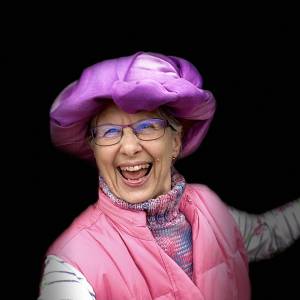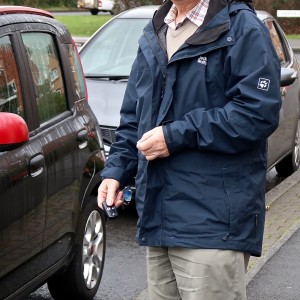MY STREET CHALLENGE - ZAKOPANE ROAD
I wonder how many of you wondered whether I would find a street in Swindon beginning with “Z”? This one is on the far side of Swindon where our son and his family live, so early this morning, we went over there to take photographs. I had decided to go on my own on the bus, but Mr. HCB said that he would like to take me as he had been with me on most of the previous photo shoots and as this was the last one, he would like to come with me for the last one. I also thought it was best to do this today rather than wait until Christmas Eve.
On this modern development built fairly recently, many of the streets and roads are named after cities and towns in Poland where our Polish twin city, Torun, is situated. Much like the streets on the site of the old hospital last week, this was quite a “rabbit warren” of streets, roads and crescents, criss-crossing each other and once again, the planners don’t seem to have taken into account that most people would have at least one and perhaps two cars per household, so the streets were chock-a-block with cars, but my faithful chauffeur managed to manoeuvre our car safely through.
The twinning began in 2003 when Torun and Swindon entered into a friendship and co-operation agreement and this covers the development of links in business, education, culture, tourism and environment between the people of Torun and Swindon. In the actual town of Torun, there is a sign which shows that it is 1,567 km to Swindon. Torun Way is named after Torun, a city with an important scientific and academic centre, where its old traditions and unique atmosphere, together with the Nicholaus Copernicus University, strongly influence the flourishing cultural life of the city.
There is a large Polish Community in Swindon, and they have their own Community Centre, so I’m not really surprised that Swindon is twinned with a Polish city and that several roads are named after Polish towns, cities, places and people.
During World War II many Poles left their homeland, being forcefully uprooted by the Russians in what was Eastern Poland and transported to central Russia as virtual prisoners of war, while others were taken by the Nazis into forced labour or put into concentration camps in Poland, Germany and Austria. At the end of the war, many Polish families were housed in hostels, schools and camps around Swindon, in Fairford and Stratton St. Margaret and as more Council houses were built in the town, they were re-housed. Many came to Swindon in the late 1940s and I remember quite a few Polish children at the schools I attended.
As I said last week, one modern housing estate is much like any other, so I thought I might just tell you a few things about the people, places and things after which the roads are named.
Zakopane Road is a town in the extreme south of Poland and it lies in the southern part of the Podhale region at the foot of the Tatra Mountains, part of the Carpathian Mountain range and the only mountain range in this part of Europe after which Tatry Road is named. It is Poland’s premier centre of mountain hiking and skiing and although it has a population of only about 30,000, it is visited by about 2 million tourists a year – some of whom may come from Swindon!
Zakopane is Poland's highest town with the highest peak in the whole of the Polish Tatras, Mt. Rysy, nearby, after which Rysy Court is named, reaching 2,499 metres above sea level. The very first documents mentioning Zakopane come from the 17th century, and describe the Zakopisko glade. Its later history was connected with the development of mining and metallurgy industries and then with the progress of health service and tourism. It gradually evolved from a little village to the region's health-resort and ultimately a reasonable-sized town, named the winter capital of Poland.
Dolina Road, leading off Zakopane Road, is named after the village of Dolina in south western Poland. Prior to 1945 it was in Germany and after World War II the region was placed under Polish administration and ethnically cleansed when the native German people were expelled and replaced with Poles.
Oberek Lane is also off Zakopane Road and this is named after a lively Polish dance, consisting of many dance lifts and jumps. It is performed at a much quicker pace than the Polish waltz and is one of the national dances of Poland.
Mazurek Way is quite a long road and as it is quite near to where our son lives, I have often wondered about the origin of its name. Mazurek, also known as Mazurka, is a variety of very sweet, flat cake made with yeast or non-yeast dough, baked in Poland for Easter and in some regions, it is also prepared for Christmas and the holiday season. It is a very rich cake or pastry, being decorated with nut or almond-based icing and often decorated with dried fruit, nuts or meringues, but sometimes left plain.
Piernik Close, off Mazurek Way, is named after a Polish gingerbread or spice cake - recipes can vary widely from town to town. Some are light, others dark. Some have dried fruits and nuts, some are cut into layers and iced with chocolate – I personally love gingerbread, so would enjoy eating it however it is made. The middle photograph in the collage is a pack of Piernikzki, chocolate covered gingerbread with an apple filling, which I purchased especially for this collage from the large Polish shop in our town centre. It was very busy and I don’t think I heard any English spoken – obviously a truly Polish shop for Polish people, with many different sights and smells; I’m sure I will enjoy a piece of the gingerbread with a cup of coffee later.
Vistula Crescent, leading off Mazurek Way, is named after the longest and largest river in Poland, being 651 miles in length. It rises at Barania Góra in southern Poland and then continues to flow over the vast Polish plains, passing several large Polish cities on its way.
Polonez Court is off Torun Way and is named after a dignified ceremonial Polish dance that from the 17th to 19th century often opened court balls and other royal functions. This dance, also known as the Polonaise in France, was used as a musical form by many prominent composters such as Beethoven, Handel, Mussorgsky and Chopin.
Kopernik Road is named after Nicolaus Copernicus, a Polish mathematician and astronomer best known for his theory that the Sun and not the Earth is at the centre of the universe.
Granica Close, which is off Kopernik Road takes its name from several villages, all of the same name, in Poland – so I daresay post is often delivered to the wrong village, unless of course, their postal system is better than ours! In one of the villages of Granica is a war cemetery, in which 800 Polish soldiers are buried from World War II.
Another road off Mazurek Way is Artus Close, which takes its name from The Artus Court, a building in the centre of Gdańsk, which used to be a meeting place of merchants and a centre of social life.
Jagoda Court, which leads from Zakopane Road, is named after a community in north western Poland and which again, before 1945 was part of Germany.
As I was doing this research, I wondered how many of the residents knew the origin of the name of their road/street. Interestingly, after I left Mr. HCB, and whilst walking towards the town centre, I heard a lady speaking to her young child and asked if she was Polish. She said she was, so we had a chat and I asked her whether she knew about the streets over at North Swindon all named after Polish towns, dances and even gingerbread. She said she didn’t but when I told her that I was on the hunt for some Piernik or gingerbread, her little boy told me he loved gingerbread men and had been given one at school.
So today’s collage brings me to the end of my Swindon Street Challenge – although I took photographs of every street/road, I couldn’t fit them all into the collage, but have still made mention of them for completeness.
After we had finished, and as we were both very cold, I treated Mr. HCB to a coffee and muffin at Costa Coffee, which is quite near to where we were – I had a gingerbread muffin, which they only serve at Christmastime, which is a shame, because they are rather scrummy and he had a blueberry one. He then left me to come on home and the bonus for me today was bumping into our granddaughter in Boots where she works.
I would like to say a special “Thank you” to Mr. HCB who has got up early and taken me out in all winds and weather so that I could take my photographs ON the day. He has been brilliant so I wanted to put him in the middle of this collage, but he said he would rather go in as an extra – so you will find him there. I hope you have enjoyed the tour round our town – I have learned so much from doing this challenge and would like to thank you for all your kind comments over the last few months - now we can both have a lie-in on a Saturday morning – until the next challenge, whatever that may be!
“There is no fun or glory
living a dull life.
You have to take a chance
and tackle challenges
to make it interesting.”
Evan Smith


Comments
Sign in or get an account to comment.


